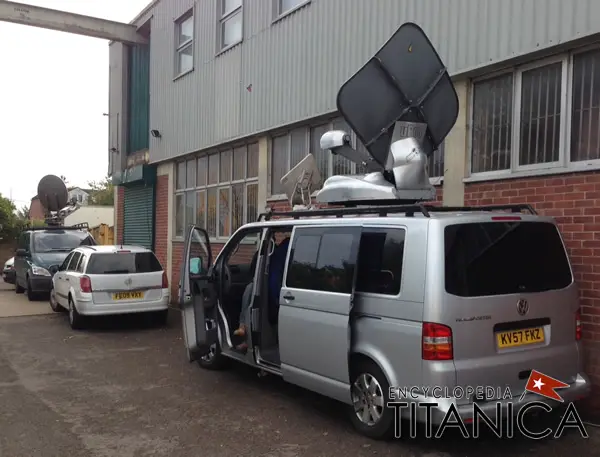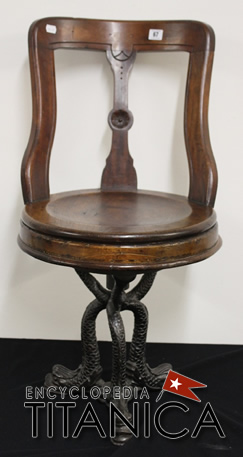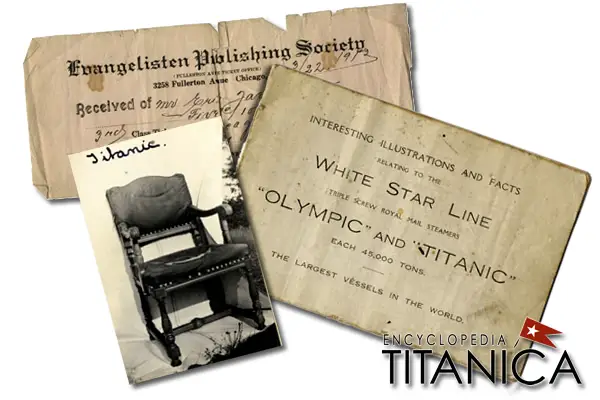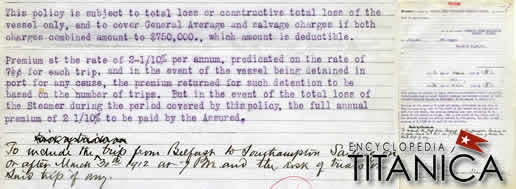After months of anticipation and speculation, the morning of 19 October 2013 finally arrived and it was the day of the auction of the Titanic’s “Holy Grail”. Seven years after the vendor had first approached the Devizes auctioneers of Henry Aldridge and Son with a damaged violin with two strings. The auctioneers had spent a significant sum on proving the violin’s authenticity and were confident their investigations, as described in part 1, had proven beyond reasonable doubt that it was the one played by band leader Wallace Hartley as the Titanic slowly sank. With investigation complete, they took the violin to exhibitions at Titanic museums in the USA where it was seen by over 350,000 people and were boldly going to the open market with an estimated value of £300,000. This estimated price of the violin easily surpassed the record set by a large cutaway plan of the Titanic used at the British inquiry. The plan had been the most expensive item of Titanic memorabilia ever auction when it was sold in April 2011 for £220,000: also by Henry Aldridge and Son. Regardless of the eventual sum the violin was expected to reach, the sale of it was going to be a spectacle of worldwide media interest. This was not down to any calculated showmanship of the auction house but due to an item, inseparable with the legend of the Titanic, being presented to the world and being sold to the lucky buyer with enough to see off all the competition.
I’ve attended auctions held by Henry Aldridge and Son as far back as 2000 and they have always been enjoyable and informal affairs with Alan Aldridge directing the bidding from the podium and his son Andrew co-ordinating from the floor. The first was where they sold the panels from the Marquis of Granby Hotel which came from first class staterooms of RMS Olympic; the Titanic’s near-identical sister ship. That auction also included a piece of wood from the Titanic that had been recovered by the Mackay Bennett. For this momentous occasion, my wife, brother-in-law and I set out from our home near London and made our way to the M4 motorway and headed westwards, coming off at Hungerford, passing through Marlborough with its famous school and continued through the beautiful English countryside. When we got to Devizes, there was a traffic jam getting into the town centre and for the first time of going to an Aldridges’ Auction when I did not find a place to park outside and had to go to a nearby side street. There was a TV satellite van parked outside and people I recognised as television reporters were darting in and out of the auction house, mobile phones in hand.

TV Vans parked outside the auction house. The auction of the Titanic violin attracted international press attention.
The room where the auction was to be held was buzzing. More people than usual were present with all the seats in front of the auctioneers’ podium taken and there being standing room only at the back and sides of the room. A bank of television cameras lined up the back of the seats. The violin itself was in a display case at the back, being displayed with two of the documents that were so crucial to establish its provenance: Maria Robinson’s diary page and the 1940 letter between the vendor’s mother and her violin teacher. The was a crowd milling around it of casual observers mingling with the world’s media, politely taking turns to be photographed with it.
It was clear that despite this auction following the form of the routine Titanic and ocean liner memorabilia auction that Aldridges’ hold every six months, everyone’s mind was focussed on one thing: the sale of lot 230 which was expected at about 3.45pm.
As is the auctioneers’ practice, they did not confine this Titanic auction to a few items costing large sums of money. The first 66 lots of the auction were mainly low value items with winning bids of less than £100. Andrew Aldridge later explained to me that they have a policy of making each Titanic auction one which is open to the wider Titanic community and is not confined to those with significant spending power. I decided to bid on a very nice linen bound, gold leaf embossed launch brochure) from the launch of the first RMS Queen Elizabeth at Clydebank in 1938 complete with high quality Dorothy Wilding portraits of King George VI and Queen Elizabeth (later the Queen Mother) who gave her name to the great ship. This item was of sentimental value to me as my father and grandparents attended that launch as my grandfather worked in the John Brown ship yard as a riveter. They may have given a copy of the same brochure I bought but likely lost it when their home was bombed in the Clydebank Blitz of 1941. I pleased to say I won this beautiful item for a mere £30 and was glad to possibly be returning a copy of it to my family.
 The bidding began to seriously heat up when we reached lot 67. A chair, distinctive as being from a turn of the century liner, was announced. Unassuming in itself, the intriguing thing about this chair was it came from the Carpathia and could have been present on the ship when she rescued the Titanic’s survivors. It was the first lot to break the four figure barrier at £2400. Lots 68 to 78 were artefacts from the Titanic’s near identical sister ship RMS Olympic with a number of lots coming from a well-documented previous auction 1991 held by Anderson & Garland in Newcastle-upon-Tyne. The items included panels from the Aft Grand Staircase and a large window frame which is the only known surviving artefact from the second class smoking room. A chair from the Olympic’s A La Carte Restaurant fetched another four figure sum at £2100. A plan of the Olympic’s first class accommodation which was authenticated as an original from 1911 by acclaimed Titanic interiors historian and author Daniel Klistorner went for £1100. A rare wash stand from the Olympic’s Mail Clerk’s quarters told for £1100 and went to a Titanic Exhibition organised by Henrik Stuifbergen.
The bidding began to seriously heat up when we reached lot 67. A chair, distinctive as being from a turn of the century liner, was announced. Unassuming in itself, the intriguing thing about this chair was it came from the Carpathia and could have been present on the ship when she rescued the Titanic’s survivors. It was the first lot to break the four figure barrier at £2400. Lots 68 to 78 were artefacts from the Titanic’s near identical sister ship RMS Olympic with a number of lots coming from a well-documented previous auction 1991 held by Anderson & Garland in Newcastle-upon-Tyne. The items included panels from the Aft Grand Staircase and a large window frame which is the only known surviving artefact from the second class smoking room. A chair from the Olympic’s A La Carte Restaurant fetched another four figure sum at £2100. A plan of the Olympic’s first class accommodation which was authenticated as an original from 1911 by acclaimed Titanic interiors historian and author Daniel Klistorner went for £1100. A rare wash stand from the Olympic’s Mail Clerk’s quarters told for £1100 and went to a Titanic Exhibition organised by Henrik Stuifbergen.
With the Olympic lots disposed of, rarer Titanic items were encountered on the road to lot 230. A rare ceramic gothic arch fruit bowl emblazoned with the White Star Line flag emblem went for £650, a Mercantile Marine medal award to Titanic Fireman Henry Noss went for £550; a certificate of discharge signed by Captain Smith when he was Captain of the first Britannic in 1893 went for £375. When lot 175 came around, an indenture from 1862 signed by Harland & Wolff owner Lord Pirrie brought the prices back to four figures, selling for £1400. It was to set the tone for the next hour or so as rarer and more unique items made their way to into the hands of new owners. Pirrie’s indenture was the first of three significant lots connected to Belfast and it was advanced by more than one of the auction attendees I spoke to that it was likely that those residing there would like to see those items retuned across the Irish Sea. With a hammer price of £5,200, original plans of “Crane equipment over nos. 2 & 3 berths” by Arrol & Co. of Glasgow dated 1909 was the second such item. If it was indeed purchased by people from Belfast, they could use them to reconstruct the gantry under which the Titanic and her sisters were built as it was demolished in the 1970s.
One of the most intriguing lots was the original insurance ledger to cover the ship's hull: “To include the trip from Belfast to Southampton sailing on or after March 31, 1912 at 7:00 P.M. and the risk of trials on said trip if any”
Finally for Belfast, the original insurance ledger covering the Titanic’s hull was up for sale. Issued by the Atlantic Mutual Insurance Company which went into liquidation two years ago after 173 years. The auction catalogue states that Atlantic Mutual was a major insurer of structures damaged or destroyed in the 9/11 attacks and the pay outs that followed that tragedy of our lifetime probably played a part in the company’s recent demise. The ledger containing the Titanic’s original insurance policy had previously been part of the company’s exhibition of historical documents. The insurance policy started at 7pm on 30 March 1912 and expired exactly a year later. The Titanic, valued at US$5,000,000, was insured for $100,000 to cover the loss of her hull. A hand written note alludes to ship’s impending sea trials and voyage from Belfast to Southampton. Sadly, the issue of this policy was fortuitous for the Titanic’s owners and payments by Atlantic Mutual to the Oceanic Steam Navigation Company were made within 30 days of 15 April 1912. The policy eventually sold for a staggering £14,000 towards the end of the auction.
Another remarkable item that fetched an eyebrow raising price was a ticket to board the Titanic, but not for her maiden voyage. It was anticipated that Titanic’s fourth voyage would take place on 11 May 1912 and would be an Eastbound Atlantic crossing. The ticket was third class, costing $57 and issued on 22 March 1912 in Chicago to Erik Jaer, a Norwegian national who had been working in the United States and it is expected that he was planning to make a trip home to Europe to visit his family. It is not known if he took another ship on 11 May to Southampton but it is known that his unused ticket for the Titanic’s fourth voyage went for £8500 about 45 minutes before Wallace Hartley’s violin was sold.

Some of the other lots that found new homes
The Titanic treasure trove continued unabated as Alan Aldridge worked his way through the 56 page catalogue he and his son had produced. A brochure for the Olympic and Titanic’s third class accommodation that I have never seen before, presumably issued in 1911, sold for £520. A photograph of a First Class dining Saloon chair that was annotated hand as being recovered in the aftermath of the sinking and was found in the archive of crewman R.D. Leigate sold for £4800. It is not known what became of the chair but if it appeared at a future Aldridges Auction, I would not be surprised! Like the violin, there is no known record of the chair having been picked up by any of the three ships charted by the White Star Line to recover bodies from the site of the Titanic’s sinking.
We were now within the last few lots before the Hartley Violin came onto the podium screen. I contacted my wife and brother-and-law who had gone for a walk in the town centre of Devizes to come back as the atmosphere in the auction room was becoming palpably tenser. A recently discovered photograph of the deck of the MacKay Bennett, with recovered bodies of Titanic victims piled waist high in canvass bags, was a prelude to the main event at lot 223. The scene depicted in the photograph is poignant and sad. It shows the decks as being crowded with people as well as the canvass body bags as a priest, Kenneth Hind, prepares to say a prayer. One of the body bags has the label 177 attached to it which means it probably belonged to leading fireman William Peter Mayo and was taken just before his body was buried at sea. This photograph also attracted some press attention in the days leading up to the auction and despite the BBC reporting that it was estimated to fetch £3000 to £4000, the hammer went down on the remarkable price of £14,000. The scene of bodies piled high on the deck of the Mackay Bennett gives credence to the notion of an intense situation on board in which it was likely recovered extraneous items would not be prioritised for recording.
Lot 227 was a telegram which detailed efforts made following the erroneous press reports the Titanic was being towed to Halifax. You may recall seeing the newspaper headline claiming that everyone had been saved and the ship was under tow in numerous books and articles over the years. This was the first time I had seen a primary source showing that the stories were believed enough for arrangements to be made for rail cars to be sent to Halifax to pick up survivors. It went for £1500. A wicker suitcase gifted by the people of New York to the family of last survivor Millvena Dean sold for £4900 at lot 228. A photograph of the tragic Elias Family from Lebanon, many of whom travelled third class and died in the sinking went for £500 at lot 229.
There then came the moment everyone had been holding their breath for…

Before proceeding to Lot 230, Alan Aldridge paused. He knew this was going to be the most important and most publicised moment in his career as an auctioneer. He began by reading out a long list of names of people that he wished to thank for their support in authenticating the violin and bringing about its sale on that day. The names included Jack Eaton and Charles Haas, Senan Molony, Dan Conlin and Philip Hind.
Known for his sense of humour, Alan then proceeded to explain how he wanted to open the bidding at £50, explaining that a taxi driver friend wanted the opportunity to own this piece of Titanic history. This bid created laughs and put the room at ease. Another very old friend would like to bid £1000. The next bid in then jumped to £80,000 and had been placed in advance on the books. Gasps greeted this “real” opening bid. The bidding then opened to the floor in the auction and to a number of bidders who were on the telephone and were held by Henry Aldridge and Son staff around dotted around the auction room. The ebb and flow of the bidding went as follows:
Alan Aldridge: “£80,000 I’ve got. 90, 100, 110, 120,130,140,150,160”
The bidding then went to the telephones.
“£150,000 which telephone would like to come in? 160, 170, 180, 190, 200?...”
After some deliberation, several bidders on the phones said “Yes” to £200,000 which was relayed by the staff taking the calls. The phone bidding continued.
Alan Aldridge “250, 275, £300,000? £350,000?” [At this point the people in the auction room gasp] £400,000? £400,000? £450,000, 500, 600"
The audience laughs uneasily.
"700, 750?" My wife turns to me and says “I’ve got goose bumps!”
But at three quarters of a million pounds, the end was not even in sight! The pace of the bidding slowed down as only three bidders were left and each had to take time to consider their decisions.
“£800, £850, £825, £850? £875?” At this point, the third remaining bidder dropped out.
“£900?”. The atmosphere was now thick enough to cut with a knife as all attention focussed on the two remaining people holding the phones. £900,000 was confirmed by Andrew Aldridge and his father asked “Any more phones coming in at £900,000?
For the first time… For the second time… All going?..”
Bang went the hammer on the sale of the violin at £900,000. The people in the auction room reacted to the sale with a rapturous and spontaneous round of applause and the atmosphere in the room turned to one of relief.
The final price the buyer would have to pay was £1,050,030 making it not only the most expensive item of Titanic Memorabilia but the first to be worth in excess of six figures.
 With Wallace Hartley’s violin successfully dealt with and sold for a record price that far exceeded expectations, the assembled media immediately went into overdrive recording their TV reports. The BBC’s Duncan Kennedy moved to the back of the room to stand by the violin’s display case and record his piece to camera. Standing nearby, I was keen to avoid featuring in a national TV bulletin but it was undoubtedly an amazing moment in the history of the Titanic enthusiasts’ community that I considered myself very lucky to witness.
With Wallace Hartley’s violin successfully dealt with and sold for a record price that far exceeded expectations, the assembled media immediately went into overdrive recording their TV reports. The BBC’s Duncan Kennedy moved to the back of the room to stand by the violin’s display case and record his piece to camera. Standing nearby, I was keen to avoid featuring in a national TV bulletin but it was undoubtedly an amazing moment in the history of the Titanic enthusiasts’ community that I considered myself very lucky to witness.
But it wasn’t over yet…
The auction had an additional twenty lots to dispose of, being with the by now infamous valise that the Violin had come packed in, bearing the initials W.H.H. and with the 90 inch long straps that Wallace Hartley had apparently used to strap it to his body. The hammer went down on it for £20,000 to a buyer who was present in the auction room. It is not known if it will ever be reconciled with the violin. Further lots were of the sheet music that was also found with the violin and the leather case it was found in. The case went for £8,000 and sheet music including the violin parts for the biggest selling gramophone record of 1911, ‘Alexander’s Ragtime Band’ and items from the 1911 number of Will Rossiter’s Band and Orchestra club went for prices ranging between £800 and £5,000. Some hitherto unseen photographs of Wallace Hartley as a boy in a music class went for £2,500 and these concluded the sale of artefacts from the Wallace Hartley / Maria Robinson collection.
Continuing despite the atmosphere being a lot more relaxed, Plans used for the 1953 film “Titanic”, a portrait of Seaman George Clench and an archive of material relating to First Class Passenger Ramon Artagaveytia were among the lots that took us toward the end of this historic day. The most sought after post-Violin item was an original poster used in travel agents in 1911 and 1912 which refers to both the Olympic and the Titanic. Most copies of this poster were destroyed after the sinking and, as a consequence, are now incredibly rare. The poster, depicting a generic illustration of an Olympic class ship by maritime artist Montague Black went for £30,000.

This amazing auction finally finished at about 4.30pm with lot 251 which was the original prop violin that was used the actor and musician Jonathan Evans-Jones in his portrayal of Wallace Hartley in James Cameron’s epic 1997 movie “Titanic”. At £9,500, it went for just over 1% of the hammer price of the actual violin it was created to represent. It seemed an altogether fitting reminder of the status of Wallace Hartley in the legend that has grown up in the many, many years since the tragedy and the heroic role he and the brave musicians he led played in the legendary story we all know so well.
Epilogue
The nature of history, the establishment of what happened in the past, is always controversial but not always well known or popular. The story of the Titanic is embedded in our popular culture even today. The irony of the “unsinkable” ship that sank, taking with her a microcosm of Edwardian Society and symbol of an era cruelly ended by the coming First World War is something that still resonates strongly with us, and has done even before the story of Jack and Rose and the discovery of the wreck.
The discovery of the Wallace Hartley Violin in 2006, set against the backdrop of controversy and legend was sure to be epoch making news. The debate around the authenticity of the violin has continued to rage in the weeks after its sale on 19 October. The sale has, if anything, thrown up further circumstantial evidence that points to the violin being genuine.
As the bidding progressed on 19 October, Andrew Aldridge later revealed that a total of nineteen bidders were prepared to part with in excess of £80,000 and that number had only diminished to ten at the £200,000 point. Bidders with these very substantial sums of money available to wager for an unplayable violin in a distressed condition were prepared to part with that money, strongly suggests that these people were convinced of its provenance. That three bidders were prepared to dogfight at the dizzy heights above three-quarters of a million pounds suggests that unless they came into their enormous wealth by pure chance, the high bidders will have applied considerable intellect to building up that wealth and also applied their intellect in assessing the evidence that was painstakingly amassed in the seven years prior to the sale.
The work done by Henry Aldridge and Son in pursuing this was described by world renowned Titanic historian Charles A. Haas as:
“The scale of the investigation that Andrew Aldridge and his team undertook to establish the authenticity of the Hartley violin was remarkable. The expenditure of months of historical research and forensic examination is a tribute to their integrity, and their dedication to the story of the Titanic, her passengers and crew.
The amount realised in bidding for the violin is a testament to the fact that, despite the passing of Titanic's centennial year, interest in the ship remains unabated."
Andrew Aldridge was not at liberty to disclose the identity of the buyer but did comment that they are very knowledgeable about the Titanic however they have interests that expand far beyond the subject that most enjoy as a hobby. It is possible that the violin will once again be put on public display but not in the immediate future.
For me, the sale of the violin is just the latest episode in the never ending fascination that the Titanic holds. Nonetheless, the personal attachment I have to the ship a century later is nothing like the personal attachment Maria Robinson had for her deceased fiancée’s violin. On receiving it, I cannot help but be struck that rather than disposing of it either as a priceless artefact or worthless junk, she kept hold of it until the end of her life as a reminder of the man she loved had he not met his tragic end doing his duty on the incredible night the Titanic went down.
Stuart Kelly is webmaster of www.rmsolympic.org and www.lastdinneronthetitanic.com and tweets as @rmsolympic1935; he has an M.A.(Hons.) degree in history from the University of Edinburgh.




Comment and discuss